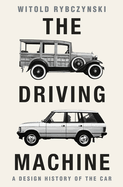
Architect and emeritus professor of urbanism at the University of Pennsylvania, Witold Rybczynski (How Architecture Works; Now I Sit Me Down) believes cars are "cultural artifacts" whose design reflects and enriches the times. This idea becomes a stimulating springboard into The Driving Machine, where, with exuberant insight, Rybczynski offers an intriguing, cross-continental history of the evolution of automobile design over 150 years. He also shares stories of the many cars he has owned over five decades.
Rybczynski creatively compares and contrasts car designs past and present. He launches his thorough yet concise examination in 1967, when he purchased his first vehicle, a Volkswagen Beetle--the "people's car" created in 1938 in response to Adolf Hitler's "national policy to motorize Germany." Throughout history, car designs have built on prior inventions. Vehicle power evolved from steam to gas-fueled to electricity. Creative ingenuity led to widespread, worldwide car ownership as vehicles eventually became more budget-friendly and, later, were mass-produced on every continent.
Designing cars requires "balancing technical demands and human needs... with aesthetics and taste." Thus, Rybczynski traverses all aspects of automotive technology--form and function--as well as car culture. The car design evolution continues today after being spurred on by the likes of innovative automotive engineering designers including Henry Ford, Walter P. Chrysler, Preston T. Tucker, and Tesla's designer, Franz von Holzhausen.
The lively charm of this accessible, enjoyably mapped-out narrative is further enriched by Rybczynski's well-crafted drawings of referenced cars. And he seamlessly weaves historical facts with personal, passionate car-themed stories and opinions. Automotive enthusiasts and general readers alike will be equally enthralled. --Kathleen Gerard, blogger at Reading Between the Lines

